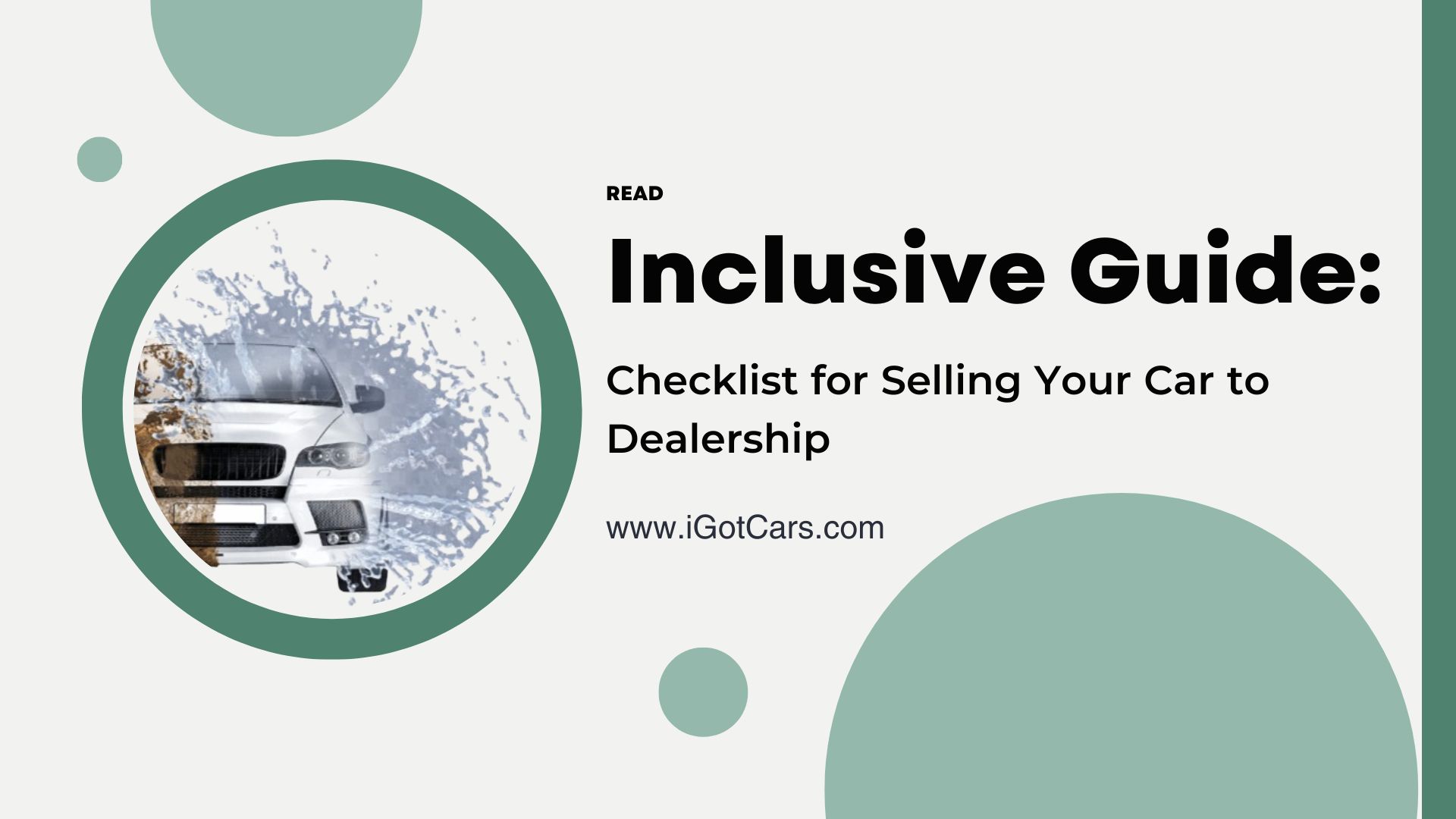-
1Personal Info
-
2Address Info
-
3Income Info
-
4Vehicle Info
-
5Review
- 850-257-7111
-
iGOTCARS
- Hours
Inclusive Guide: Checklist for Selling Your Car to Dealership

Selling your car at a dealership can streamline the process and offer convenience, especially if you’re looking for a hassle-free transaction. However, to ensure a smooth and successful sale, it’s crucial to be prepared and organized. Creating a checklist can help you stay on track and cover all the essential steps involved in selling your car at a dealership. In this guide, we’ll provide a comprehensive checklist to follow when selling your car at a dealership, whether you’re trading in for a new vehicle or simply looking to sell.
- Gather Documentation: Start by gathering all the necessary documentation related to your vehicle. This includes the title, registration, maintenance records, and any relevant warranty information. Having these documents readily available will expedite the selling process and instill confidence in potential buyers.
- Research Market Value: Before approaching a dealership, research the market value of your car to ensure you’re pricing it competitively. Use online resources, such as Kelley Blue Book or Edmunds, to determine the fair market value based on factors like the vehicle’s make, model, year, mileage, and condition. Knowing the approximate value of your car will help you negotiate a fair price with the dealership.
- Clean and Detail Your Car: First impressions matter, so take the time to clean and detail your car before bringing it to the dealership. Wash the exterior, vacuum the interior, and remove any clutter or personal belongings. Consider investing in professional detailing services to give your car a showroom-worthy appearance, which can significantly enhance its curb appeal and perceived value.
- Address Mechanical Issues: If your car has any mechanical issues or maintenance needs, address them before attempting to sell it at a dealership. Minor repairs or maintenance tasks, such as oil changes, tire rotations, or brake replacements, can improve the overall condition of your car and increase its desirability to potential buyers. Addressing these issues proactively can also prevent any surprises during the inspection process.
- Obtain Pre-sale Inspection: Consider getting a pre-sale inspection from a trusted mechanic to assess the condition of your car thoroughly. A professional inspection can identify any underlying issues or mechanical concerns that may affect the sale price or deter potential buyers. Providing a clean bill of health from a reputable mechanic can instill confidence in the dealership and prospective buyers.
- Prepare Necessary Accessories: Gather any accessories or additional items that come with the car, such as spare keys, owner’s manuals, maintenance records, and floor mats. Having these items readily available demonstrates that you’ve taken good care of your car and adds value to the overall package. Additionally, consider including any aftermarket upgrades or modifications that may enhance the car’s appeal.
- Contact Dealerships: Research dealerships in your area that offer in house financing auto sales or buy here pay here car lots in pensacola fl . Contact them to inquire about their buying process and schedule an appointment to have your car appraised. Be prepared to provide details about your car, including its make, model, year, mileage, condition, and any additional features or upgrades.
- Negotiate Trade-in Value: If you’re trading in your car for a new vehicle, be prepared to negotiate the trade-in value with the dealership. Present your research on the market value of your car and be open to negotiations to reach a fair price. Keep in mind that dealerships may offer incentives or promotions for trade-ins, so explore all available options to maximize your return.
- Review and Sign Paperwork: Once you’ve agreed on a price with the dealership, review and sign the necessary paperwork to finalize the sale. This may include a purchase agreement, bill of sale, title transfer, and any additional documents required by state or local regulations. Make sure to read and understand all terms and conditions before signing to avoid any misunderstandings or discrepancies.
- Transfer Ownership and Receive Payment: After completing the paperwork, transfer ownership of the vehicle to the dealership and ensure that you receive payment for the agreed-upon amount. Depending on the dealership’s policies, payment may be issued via check, direct deposit, or wire transfer. Verify that the payment is processed securely and that you receive a receipt or confirmation for your records.
- Remove Personal Belongings: Before leaving the dealership, double-check to ensure that you’ve removed all personal belongings from the car. This includes items stored in the glove compartment, center console, trunk, and any other compartments or storage areas. Take one last look around the car to ensure it’s clean and empty before saying goodbye.
- Follow Up and Provide Feedback: After the sale is complete, consider following up with the dealership to provide feedback on your selling experience. This can help them improve their processes and customer service and may also lead to future referrals or recommendations. Additionally, keep the dealership’s contact information on hand for any questions or concerns that may arise after the sale.
In conclusion, selling your car at a dealership can be a convenient and straightforward process if you follow a comprehensive checklist and approach the transaction with preparation and diligence. By gathering the necessary documentation, researching the market value, cleaning and detailing your car, addressing mechanical issues, and following through with negotiations and paperwork, you can ensure a smooth and successful sale. Whether you’re trading in for a new vehicle or simply looking to sell, following these steps will help you navigate the process with confidence and achieve a favorable outcome.
Sales Hours
Mon - Fri: 8:30AM - 6:00PM
Saturday: 8:30AM - 6:00PM
Sunday: Closed
Copyright © 2020-2021 | iGOTCARS
